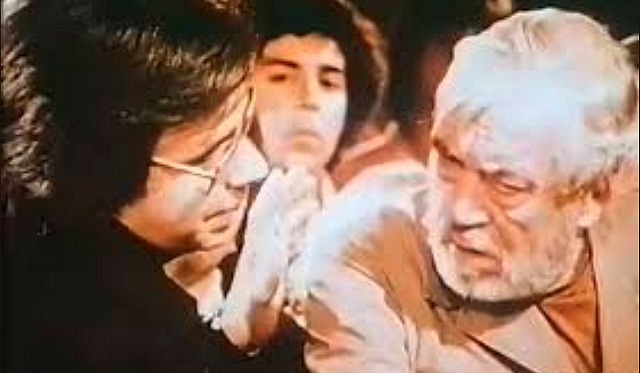As noted, the first-ever screening of a full-boat version of Orson Welles‘ The Other Side of the Wind happened last Tuesday night (1.16) at Santa Monica’s Ocean Ave. screening room. The reconstituted, inside-the-industry, early ’70s montage-hodgepodge will presumably be refined a bit more before debuting at the 2018 Cannes Film Festival.
HE to friend who attended Tuesday’s screening: “Is it…what, a fascinating but surreal early ’70s timepiece? Is it a slipshod, free-associative whatsit without a narrative spine, or does it sorta kinda have something going on? Orson was a near-genius at times, and he obviously did his very best and worked his fingers to the bone, but be honest — is it some kind of visual dazzler, an interesting piece-of-shit or a major discovery or what? Can you give me a thought or two or a hint or two about how it plays, how it feels?”

Cruddy, bleachy image of scene from The Other Side of the Wind with costars Peter Bogdanovich, John Huston.
Friend to HE: “[The film we saw Tuesday] is very much in the spirit of the pre-existing 42 minutes of cut footage, which have been around forever. DP Gary Graver used to regularly screen it. Are you familiar with that material?”
HE to friend: “Naah, never saw it. So the whole movie feels like an expanded version of 42 minutes of cut footage? It doesn’t have shape, narrative tension, thematic clarity, a second-act pivot, a strong ending…NONE of that stuff? Just a grab-bag of cut footage, only longer? That doesn’t say much for the editors, does it? All this work, all these years and all this trouble and expense, and it’s a sprawling cut-footage wank-off? C’mon, there has to be more to it than this. Orson Welles is listening from above.”
Friend to HE: “No, what we saw is not a longer version of the 42-minute cut footage. Josh Karp wrote an entire book about the film which lays it all out. But in a nutshell, this is not just ‘expanded footage'” This is not a short film which has been made longer.
“Orson had a feature script. He shot that movie, infamously, over a period of years. Then he fine-cut the 42-minute version. Then he got busy, got distracted and then died. The 42 minutes were scenes from different parts of the story. The 42-minute reel is famous because its cutting style is so radical — Orson was trying to reinvent editing and shooting styles, as collage.
“The only thing I can compare it to would be parts of JFK, decades later, where Oliver Stone and Bob Richardson were intercutting lots of film stocks and jumping around, to keep you off-balance.
“The footage has two styles — (a) the cutty, jumpy documentary style, which follows the characters, and (b) the movie-within-the-movie, which [offers] a very composed, beautiful, landscape type of photography, sort of mocking Antonioni. But none of this is secret. The footage has been circulating for decades. The script has been published. So this radical style has been known forever.
“The editing team has cut the remaining uncut footage, doing their best to follow the two editing styles which Orson already established. The result is pretty seamless. It is very definitely of the time — it feels very early ’70s experimental. A hint of what he was going for would be in his other film from this era, F For Fake, which is heavy on collage. Orson called it an ‘essay film.’ If you watch that movie, you’ll get a sense of what Orson was up to. He was trying to throw out the rules and reinvent things.
“The OSOTW Wikipedia page is pretty accurate, laying out the three-act story. It’s hard to describe the results with a quick quip — I’d say ‘collage’ is the word that best comes to mind.”












